Index
This topic area covers statistics and information relating to the Hull’s physical geographical area and some information relating to the environment including local strategic need and service provision. Further demographic, health and wellbeing information relating to specific geographical areas such as electoral wards under Ward Profiles within Place. Further information on the environmental factors of Air Pollution and Climate Change can be found within Health and Wellbeing Influences.
More information relating to the population differences between the NHS geography (based on patients registered with Hull GPs) and the local authority (based on residents of Hull) and the difference in these estimates from different data sources is given on Population Estimates under Population. Further information on the differences in the type of housing and household composition within Hull can be found on Housing and Households under Health and Wellbeing Influences.
This page contains information from the Office for Health Improvement & Disparities’ Fingertips. Information is taken ‘live’ from the site so uses the latest available data from Fingertips and displays it on this page. As a result, some comments on this page may relate to an earlier period of time until this page is next updated (see review dates at the end of this page).
In July 2022, Clinical Commissioning Groups (CCGs) ceased to exist and were replaced by the Integrated Care System. Data will still be available at CCG level for some time after July 2022 so the JSNA will continue to reference CCGs and Hull CCG as well as the larger geographical area Humber, Coast and Vale which included Hull CCG. New data is becoming available for Hull’s Health and Care Partnership and is referred to as sub Integrated Care Board and referenced by 03F for Hull within Fingertips, as well as data being available for the larger local geographical area – the Humber and North Yorkshire Health and Care Partnership or Humber and North Yorkshire Integrated Care Board.
Headlines
- The geographical boundaries in Hull are tight and exclude the more affluent suburban areas unlike other cities. This means that Hull is ranked among the most deprived local authorities in England.
- It is estimated that 45% of Hull’s population live in the bottom fifth of areas nationally based on the Access to Healthy Assets and Hazards index which measures multidimensional features of the built environment including accessibility to retail services (fast food outlets, pubs, gambling stores, etc), health services, green spaces and overall air quality. The index can be considered to be a measure of the unhealthy environments present. The percentage in Hull is far greater than England (21%) and the other 14 local authorities across the Yorkshire and Humber region (range 1.3% to 32.6%). Outside the concentrated density of London (where most local authorities have the majority of the population in the bottom fifth including the City of London where all their population is included in the bottom fifth of areas), Hull has among the highest percentages being fifth highest of the 120 upper-tier local authorities outside London.
- Hull is 71.6 kilometres square and has around 3,800 residents per square kilometre. Hull is in the top fifth of lower-tier local authorities with the highest population density.
- It is likely that some people in Hull move to the ‘leafy suburbs’ in East Riding of Yorkshire just outside Hull’s boundary each year. The more aspirational, successful and motivated people will tend, on average, to have increased mobility, and this affects the employment and skills profile of Hull.
- Owing to Hull’s somewhat isolated location, people may be less likely to be influenced by positive health factors occurring elsewhere.
- The geographical boundaries for Hull local authority are the same as for Hull’s Health & Care Partnership (sub Integrated Care Board area), although the population size if different. The estimate resident population was 275,401 people from the Office for National Statistics mid-year 2024, but the number of patients registered with Hull GPs was 314,215 patients as at July 2025 (and around 8% of these patients live in East Riding of Yorkshire). Furthermore, the GP registration file includes almost 20,000 ‘extra’ residents compared to the Office for National Statistics resident population estimates (8% of total residents in the registration file). Some of these ‘extra’ residents are likely to be ‘ghost’ patients who are have moved away but have not registered with another GP in England (either because they haven’t been ill since moving or they moved abroad – some of which may have been students).
The Population Affected – Why Is It Important?
In order to improve health and reduce inequalities, it is important to understand the make-up of the local population, the geographical area and the environment. Features within the geographical areas, such as rivers or the location of residential, commercial and industrial areas, or the way in which boundaries have been derived can all influence the health needs of the local population, and also their access to services.
As the World Health Organisation states “Humans interact with the environment constantly. These interactions affect quality of life, years of healthy life lived, and health disparities.” WHO defines environment, as it relates to health, as all the physical, chemical, and biological factors external to a person, and all the related behaviours. From Healthy People 2020, environmental health consists of preventing or controlling disease, injury, and disability related to the interactions between people and their environment.
The World Health Organisation estimate that 24% of the global disease burden and 23% of all deaths can be attributable to environmental factors, and that this figure is higher for children aged 0-14 years (36% for deaths). The overall figures are lower in high income countries and it is estimated that this figure is around 14% on average in Europe in relation to deaths. However, there are large inequalities both between and within countries.
Environmental factors include indoor and outdoor air pollution, climate change, extreme weather events, flooding, drought, unsafe drinking water, chemical and radiation exposures, leaks and contaminations including contaminated land, exposure to lead, asbestos and other substances and chemicals, exposure to other adverse substances in the home such as mould, noise pollution, light pollution, and a number of other environmental factors.
While Hull has relatively good air quality, air pollution is a major cause of premature death and disease, and is the single largest environmental health risk in Europe according to the European Environmental Agency.
The Intergovernmental Panel on Climate Change state that we are currently experiencing the greatest change in the natural environment in human history. The threat of climate change as a result of the increase of greenhouse gases by human activity is pushing known planetary boundaries in areas such as species loss, air quality, natural resources and extreme weather events. The increasing global population expansion and dietary change is putting pressure on agriculture and land use.
As stated by the government, the transition to a low carbon society to combat these environmental threats provides challenges in energy generation and its use, urban transport to combat air quality and improve physical health and improving the resilience and adaptability of our communities particularly the most vulnerable.
The Hull Picture
About Hull
The city and port of Hull lies on the north bank of the Humber estuary and is positioned at the gateway to Europe. It is linked to the national motorway networks from the west via the M62 and to the south across the Humber Bridge via the M180. Hull’s city boundary is roughly semi-circular with a radius of approximately 4.4 miles or 7 kilometres. The city is compact and highly urbanised. It is one of the most densely populated local authorities in the Yorkshire and Humber region. Hull serves large rural and coastal areas in neighbouring local authorities, and is surrounded by the East Riding of Yorkshire to the north, east and west, and by the Humber estuary to the south. The River Hull runs through the middle of the city from north to south with industries traditionally located around the rivers of Hull and the Humber forming an inverted T-shape of industrial areas in Hull. Hull is flat and low lying which has previously resulted in problems with flooding (in 2007 due to heavy rainfall and in 2013 due to a tidal surge). With the tight urban boundary, many small towns and villages in neighbouring East Riding of Yorkshire are located on the periphery of the boundary, and generally constitute the ‘leafy suburb’ areas of the city. As a result of these more affluent suburb areas falling outside the city boundary (unlike many other local authorities where parts of these suburb areas fall within a city’s boundary), Hull is among the most deprived local authorities in England.
The Hull travel-to-work areas, which covers a large percentage of East Riding of Yorkshire, has one of the highest levels of commuter self-containment in the country. This means that Hull has high levels of visitor populations who visit Hull for work, retail and leisure purposes.
Hull has some outstanding cultural and historic assets, many of national and international significance. Hull has a good distribution of parks and open spaces, and green space makes up around a third of land use (34.4%). The largest land use is then followed by domestic gardens (20.6%), roads (13.0%), domestic buildings (8.6%), non-domestic buildings (6.4%), water (2.5%), paths (1.6%) and rail (0.6%), with the remaining 12.3% defined as other land uses. Hull is a total of 7,154 hectares.
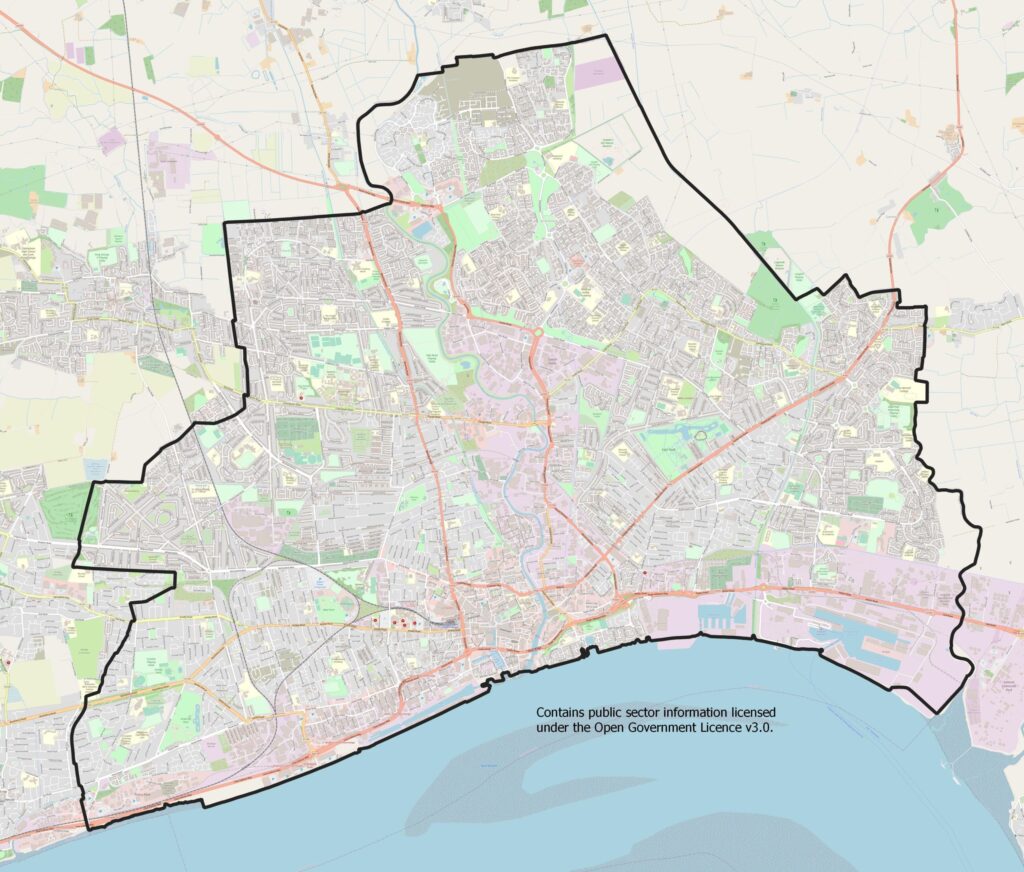
Since Hull was announced as the UK’s City of Culture 2017, numerous multi-million pound investments have revitalised and transformed the city centre. Investments of more than £1 billion have flowed into the city, creating thousands of jobs, and over £3 billion in total from public and private investment. Thousands of volunteers helped deliver the cultural programme in 2017 with nine in ten people in Hull taking part in City of Culture events. Visitor numbers increased dramatically. Following on from its success, the City of Culture legacy has been embedded in every stage of the UK City of Culture journey and has been the topic of the 2016 Director of Public Health Annual report with a ten-year Cultural Strategy 2016-2026 launched in a bid to sustain the economic boom and “put culture and the arts at the heart of Hull’s regeneration and development”.
Hull’s Tight Geographical Boundaries
In relation to the characteristics of Hull, one problem relatively unique to Hull is its tight geographical boundaries. Most cities such as Hull are relatively deprived, but most other local authority or NHS boundaries include some more affluent suburban areas. Hull has very few affluent suburbs within its boundaries, and it is estimated that a number of people in Hull move to the ‘leafy suburbs’ in East Riding of Yorkshire just outside Hull’s boundary each year. The people that tend to move will often do so because of children and better schools, better quality and choice of housing, etc. The more aspirational, successful and motivated people will tend, on average, to have increased mobility. This also affects the employment and skills profile of Hull. Furthermore, owing to Hull’s somewhat isolated location, people may be less likely to be influenced by positive health factors and changes occurring elsewhere in other geographical areas. Due to Hull’s high levels of deprivation and tight boundaries, Hull is often at the bottom of national league tables and among the ‘worst’ for various indicators for both health and the wider determinants of health. As a result, there are often negative comments made about Hull, which can influence attitudes, health and lifestyle. Within local qualitative research projects, there were certainly some residents that had a “what’s the point?” attitude with regard to their health and lifestyle changes, however, others felt that this was just an excuse “You can lead a healthy lifestyle anywhere, it’s not the place – I staunchly defend Hull– it’s about choices”.
From the Office for National Statistics population estimates for 2024, Hull is 71.6 kilometres square and has an estimated 3,846 residents per square kilometre. Hull is in the fifth of lower-tier local authorities in terms of having high population density.
Hull’s Location Within the Yorkshire and Humber Region
Hull is one of 15 unitary authority in the Yorkshire and the Humber region, and Hull is both a lower-tier and upper-tier local authority as are the other 14 local authorities in the region (North Yorkshire was previously split into seven lower-tier local authorities).
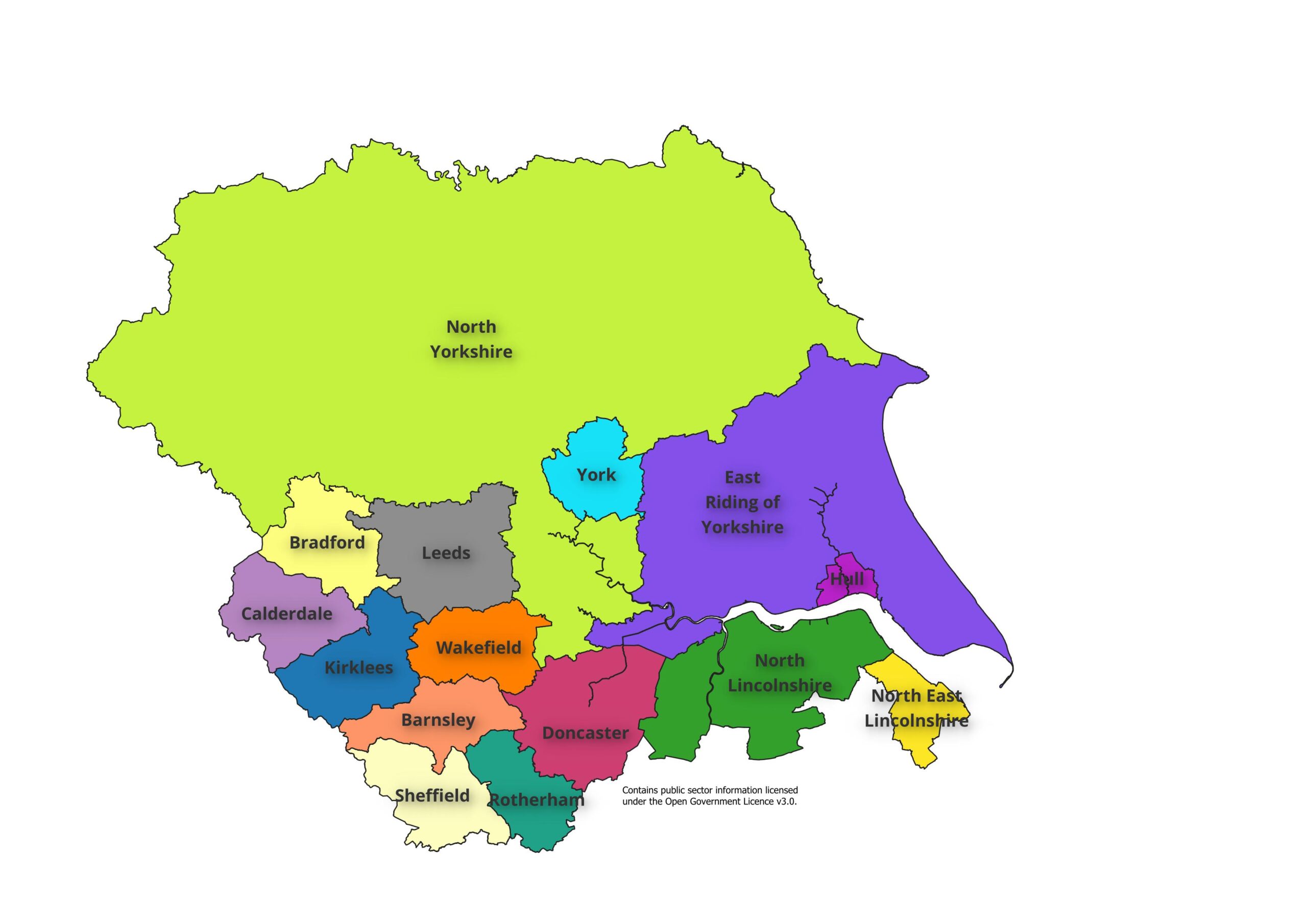
Hull’s Electoral Wards
There were 23 wards in Hull prior to May 2018 and this had been the case for more than a decade. In May 2018, the number of wards in Hull reduced to 21, and the boundary of every single ward changed. Some changes were relatively minor, but other changes were much more substantial. The names of around half of the wards remained the same despite changes to all the boundaries. These also ranged from relatively minor changes to entirely new names for some wards. Prior to April 2023, Hull was divided into seven Area Committee Areas each covering three wards with North Carr, Kingswood, and West Carr in Foredyke Area, Beverley & Newland, Orchard Park, and University in Northern Area, Ings, Longhill & Bilton Grange, and Sutton in East Area, Holderness, Marfleet, and Southcoates in Park Area, Drypool, Newington & Gipsyville, and St Andrew’s & Docklands in Riverside Area, Boothferry, Derringham, and Pickering and West Area, and Avenue, Bricknell, and Central in Wyke Area.
As at April 2023, there are three Area Committee Areas of North, East and West as illustrated in the map below.
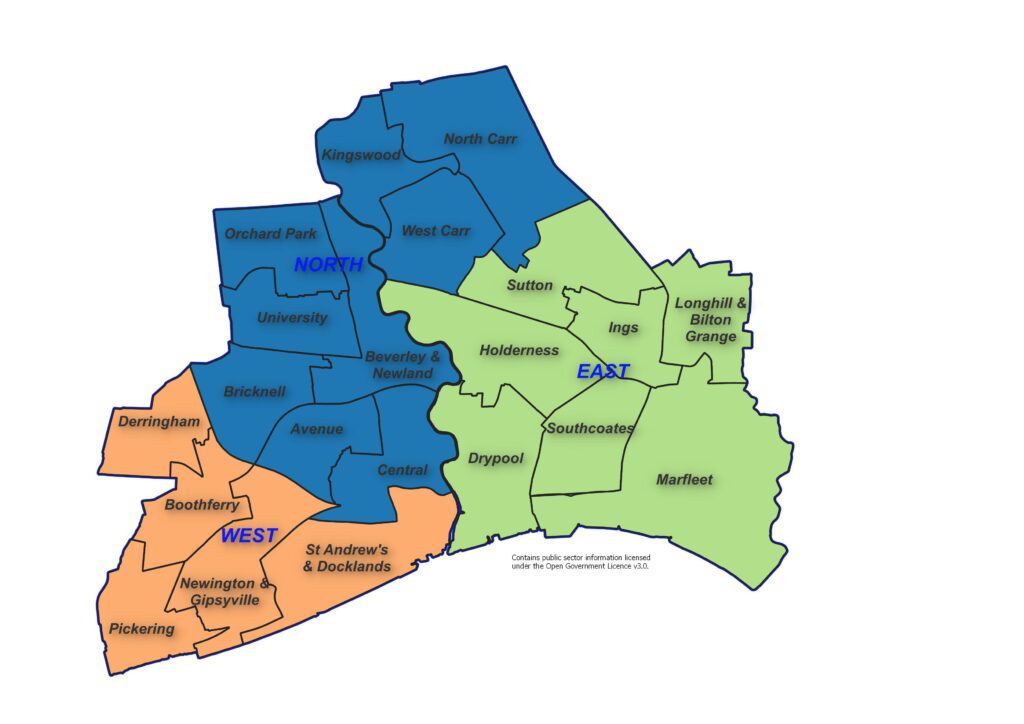
Geographical Boundaries Relating to the NHS
The other key geographical boundary for Hull in terms of health relate to those associated with the NHS.
Prior to April 2013, the NHS comprised of Primary Care Trusts (PCTs), and between April 2013 and June 2022, the local NHS geographical area was made up from Clinical Commissioning Groups (CCGs). There were also Sustainability and Transformational Partnerships (STPs) made up of a number of local CCGs. Prior to July 2022, Hull was included within the Humber, Coast and Vale (HCV) STP (which included five other local CCGs: North Yorkshire, Vale of York, East Riding of Yorkshire, North Lincolnshire and North East Lincolnshire). The STPs were later transformed into Health and Care Partnerships (HCPs), and there have been further changes to the NHS geography in July 2022 with Integrated Care Systems.
The Integrated Care System (ICS) is made of up two core statutory elements at system level formerly came into effect on 1 July 2022 when CCGs ceased to exist. The ICSs are where major decisions are made, and overarching strategies agreed. The Integrated Care Boards (ICB) replace CCGs and are focused on the core NHS services, with responsibilities including NHS funding, commissioning and workplace planning. The Integrated Care Partnerships (ICP) have a broad focus, covering ICB-wide strategy, public health, social care, and wider issues impacting the health and wellbeing of the population. There will continue to a Place element within the ICS, and this will involve the planning of localised services and secondary and community care. NHS England sees ‘place’ as the key driver of change within ICSs and they are expected to be where the majority of work actually occurs. Data will continue to available at CCG level for some time and as a result CCG will still be referenced within our Joint Strategic Needs Assessment, and will gradually be replaced over time as the new system is embedded and new data becomes available at the new geographical levels.
The Office for Health Improvement & Disparities’ Fingertips includes some information at sub-ICB level, and Hull is referenced by its CCG code of 03F.
All areas within the Humber and North Yorkshire Integrated Care Board are:
- 02Y – East Riding of Yorkshire
- 03F – Hull
- 03H – North East Lincolnshire
- 03K – North Lincolnshire
- 03Q – Vale of York
- 42D – North Yorkshire
Hull’s Place element is Hull’s Health and Care Partnership, and the Humber, Coast and Vale Health and Care Partnership also ceased to exist and Hull is included in the Humber and North Yorkshire Health and Care Partnership or the Humber and North Yorkshire Integrated Care Board (ICB).
The geographical boundary of the local authority is the same as the boundary for the NHS in Hull, although the population size if different. The resident population is estimated to be 275,401 people in 2024, but the number of patients registered with Hull GPs in July 2025 is 314,251 patients (and around 8% of these patients live in East Riding of Yorkshire). For more information about the difference between the resident population and registered population, see Population Estimates under Population.
The local authority and sub Integrated Care Board boundaries are coterminous for Hull, North East Lincolnshire and North Lincolnshire, and are similar for East Riding of Yorkshire local authority. However, they differ substantially for North Yorkshire and York local authorities. North Yorkshire upper-tier local authority previously contained seven lower-tier local authorities of Selby, Craven, Richmondshire, Harrogate, Hambleton, Ryedale and Scarborough. The Vale of York sub Integrated Care Board contains York local authority and what was previously Selby and parts of Hambleton and Ryedale lower-tier local authorities. Additionally, Vale of York also contains part of East Riding of Yorkshire local authority (around Pocklington).
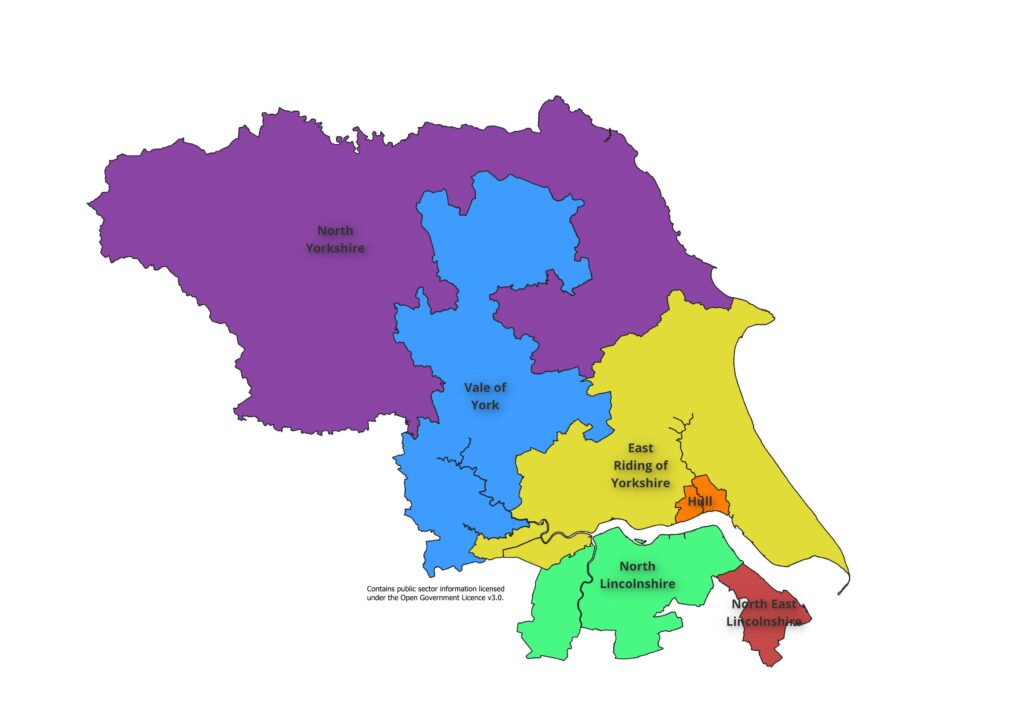
Environmental Factors
Access to Healthy Assets and Hazards Index
The Access to Healthy Assets and Hazards (AHAH) index is designed to allow policy and decision makers to understand which areas have poor environments for health, and to help move away from treating features of the environment in isolation.
The Access to Healthy Assets and Hazards index is comprised of four domains: access to retail services (fast food outlets, gambling outlets, pubs/bars/nightclubs, off licences, tobacconists), access to health services (GP surgeries, A&E hospitals, pharmacies, dentists and leisure centres), the physical environment (green and blue spaces) and levels of air pollution (nitrogen dioxide (NO2), particulate matter smaller than 10 microns (PM10) and sulphur dioxide (SO2)). The Access to Healthy Assets and Hazards index provides a summary of an area’s relative performance on these indicators (the second and third domains conceptualised as health promoting and the first (access to retail) as health demoting. It therefore provides information on how conducive to good health an area is relative to other areas, for the specific indicators.
Public Health England’s (now the Office for Health Improvement & Disparities) Spatial Planning for Health document states that an ‘ever-increasing body of research indicates that the environment in which we live is inextricably linked to our health across the life course. For example, the design of our neighbourhoods can influence physical activity levels, travel patterns, social connectivity, mental and physical health and wellbeing outcomes.’ The indicator is intended to support interventions to improve the health promoting qualities of the environment, and is primarily aimed at those working in public health roles in local authorities.
The Access to Healthy Assets and Hazards index is constructed given equal weight to the different measures and domains. It is therefore designed as a balanced description of an area with regard to these domains, and not as a summary of the health impacts on the population.
Overall Index
The Access to Healthy Assets and Hazards index is originally produced at lower layer super output area geographical level as an average of values for constituent postcodes but has been presented at local authority level in the Office for Health Improvement & Disparities’ Fingertips.
The Access to Healthy Assets and Hazards index is presented as percentage of the total population residing in lower super output areas defined as in the bottom 20% of all areas on the Access to Healthy Assets and Hazards Index as a percentage of the total population of the area.
In 2024, the Access to Healthy Assets and Hazards Index is very high in Hull with 44.7% of Hull’s population residing in the bottom fifth of areas nationally in relation to the Access to Healthy Assets and Hazards Index. The percentage nationally is 20.9% and across the other 14 lower tier local authorities in the region the range is from 1.3% to 32.6%.
In London, 23 of the 33 upper-tier local authorities have a higher percentage of their populations living within areas in the bottom fifth of areas nationally in relation to the Access to Healthy Assets and Hazards Index due to the high population density of many London local authorities. This includes 11 London upper-tier local authorities where three-quarters or more of their populations are living within areas in the bottom fifth of areas nationally in relation to the Access to Healthy Assets and Hazards Index including the City of London where all its population fall into this category. Outside London, Hull has the fifth highest percentage among the 120 upper-tier local authorities outside London being lower than Thurrock (74%), Liverpool (53%), Leicester (47%) and Oldham (45%).
Compared with benchmark
| Indicator | Period | England | Yorkshire and the Humber region (statistical) | Kingston upon Hull | East Riding of Yorkshire | North East Lincolnshire | North Lincolnshire | York | North Yorkshire UA | Barnsley | Doncaster | Rotherham | Sheffield | Bradford | Calderdale | Kirklees | Leeds | Wakefield |
|---|---|---|---|---|---|---|---|---|---|---|---|---|---|---|---|---|---|---|
Access to Healthy Assets & Hazards Index (Persons All ages) | 2024 | 20.9 | 18.2 | 44.7 | 9.4 | 23.6 | 10.7 | 1.3 | 13.4 | 10.2 | 6.2 | 9.7 | 13.7 | 32.6 | 5.1 | 13.1 | 30.3 | 18.8 |
| Indicator | Period | England | Yorkshire and the Humber region (statistical) | Kingston upon Hull | East Riding of Yorkshire | North East Lincolnshire | North Lincolnshire | York | North Yorkshire UA | Barnsley | Doncaster | Rotherham | Sheffield | Bradford | Calderdale | Kirklees | Leeds | Wakefield |
|---|---|---|---|---|---|---|---|---|---|---|---|---|---|---|---|---|---|---|
Access to Healthy Assets & Hazards Index (Persons All ages) | 2024 | 20.9 | 18.2 | 44.7 | 9.4 | 23.6 | 10.7 | 1.3 | 13.4 | 10.2 | 6.2 | 9.7 | 13.7 | 32.6 | 5.1 | 13.1 | 30.3 | 18.8 |
Despite the very high levels in Hull, the index has decreased considerably since 2016 when nine in ten residents lived in the worst fifth of areas of England in relation to the index, although there was a large decrease between 2016 and 2017 to 46% with only relatively minor changes to 2022 and 2023.
In 2024, it is estimated that 120,220 residents in Hull live within areas defined as the bottom fifth of areas nationally based on the Access to Healthy Assets and Hazards Index.
Compared with benchmark
Access to Healthy Assets & Hazards Index (Persons All ages)
|
Period
|
Kingston upon Hull |
Yorkshire and the Humber region (statistical)
|
England
|
||||
|---|---|---|---|---|---|---|---|
|
Count
|
Value
|
95%
Lower CI |
95%
Upper CI |
||||
| 2016 | • | 233157 | 90.0% | - | - | 22.2% | 21.2% |
| 2017 | • | 120814 | 46.3% | - | - | 14.1% | 21.1% |
| 2022 | • | 114694 | 44.3% | - | - | 19.9% | 22.6% |
| 2024 | • | 120220 | 44.7% | - | - | 18.2% | 20.9% |
Source: Consumer Data Research Centre
Information relating to version 4 of the Access to Healthy Assets and Hazards index is available at lower layer super output area geographical level. There are 33,755 lower layer super output areas in England, and the percentile score has been calculated for each of the 168 lower layer super output areas in Hull. The index was updated in July 2024. The air pollution data is from the Department for Environment, Farming and Rural Affairs (DEFRA) for 2022. Locations of health facilities data is available quarterly so the data will relate to data from 2024, and retail facilities location data and the blue and green space indicators relate to data within the last year or so.
As Hull is a city and a relatively densely populated city with tight boundaries, it does mean that there is not far to travel with regard to access to healthcare in that that most of the population are as short drive away from the nearest dentist, GP, hospital and pharmacy. This results in Hull having a relatively good score in relation to to the health index. However, this also means that drive times are low to ‘unhealthy’ places such as fast food outlets, gambling outlets, pubs/bars/nightclubs, off licences and tobacconists. Areas with more dense areas of industry and cities with more roads will also tend to have higher levels of pollution than more rural areas. Hull tends to have a relatively high number of green spaces (as mentioned above around one-third of Hull is green space) and with the proximity of the Humber estuary and the River Hull, there is also only a short drive to the nearest blue space in Hull.
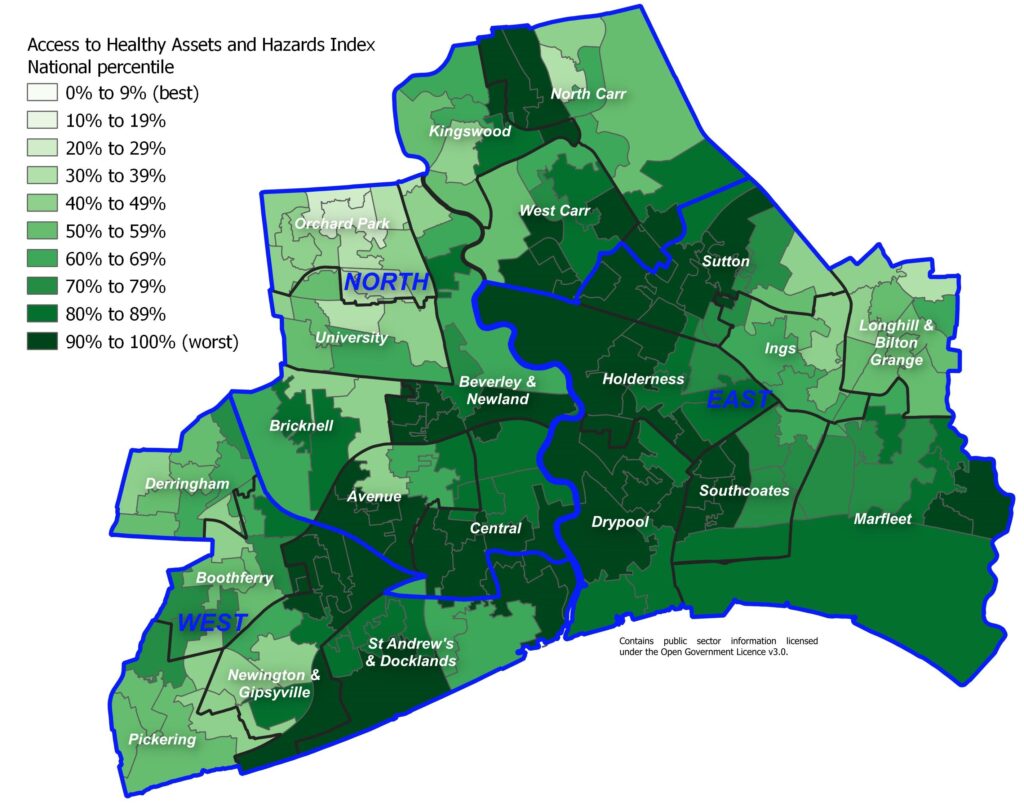
Usefulness and Problems Associated with the Index
It is useful to examine the index as a whole, but with the caveats associated with some of the individual components of the index, it is also useful to examine the individual components to assess potential issues or hazards for people living in the different areas of the city. The individual components of the index are mapped below.
Whilst the index is useful to examine the distribution of assets and hazards, it is also imperative that local knowledge is used to assess individuals components of the index and to recognise that the index does not portray the full picture with regards to healthy assets and hazards for the following reasons:
- Many of the indicators are based on drive times with an inherent assumption that residents have access to a car or van. In a city with good transport networks and problems with parking, car ownership tends to be lower than more rural areas and car ownership is lower in more deprived areas of the city as well as areas closer to the city centre. From the 2021 Census, 35% of household had no cars or vans in the household compared to 23% for England. If people need to rely on public transport, cycling or walking then it is likely that travel times are longer. This is particularly the case if it is necessary to catch more than one bus and also there could be cost implications too. In many cases, from anecdotal evidence, people in Hull are less likely to travel to services if they need to catch more than one bus, and some of the more deprived areas of Hull do not have direct services into the city centre.
- Drive times to the nearest dentist does not reflect any access, and it is likely that most dental surgeries are not accepting new NHS clients so access to dental services in Hull is difficult particularly for people living in deprived areas who are less able to pay for private dental services.
- Drive times to the nearest blue space and the ‘greenness’ of the immediate area does not reflect quality of that space or accessibility. As Hull is on the Humber estuary and has the River Hull running through the city, most areas in Hull have low drive times to the nearest blue space, but the banks of the Humber estuary and River Hull are not necessarily places where most people would want to spend much leisure time. Green space is measured by satellites as the average Normalised Difference Vegetation Index as close to summer equinox as possible. The Normalised Difference Vegetation Index takes a value from zero (no vegetation or dead vegetation) to one (very healthy vegetation) and the measure of green space in the Access to Healthy Assets and Hazards index uses the average Normalised Difference Vegetation Index for an 80 metre radius around the postcode centroid for each postcode (the rational is that the average extent of a postcode in the UK is around 160 metres by 160 metres). Therefore, it is essentially measuring the ‘greenness’ of an area. This does not necessarily equate to assess and quality of that space. Other people’s gardens would be included in the green space measure. Furthermore, even if the green space is a public space, other factors may influence its use such as feelings of safety (and feelings of safety do differ by deprivation in Hull).
- Drive times to other facilities such as those related to healthcare or leisure facilities do also not take into other factors related to access such as cost, quality or waiting times, etc.
- The measure will not include informal networks in relation to illegal products such as tobacco or alcohol. The majority of alcohol is purchased in off-licences, shops and supermarkets which are not taken into account as the nearest pub, bar or nightclub is included in the index.
- Access to fresh fruit and vegetables are very important in relation to having a healthy lifestyle and there are many areas in Hull where there is a lack of such access which include some of the more deprived areas such as Orchard Park.
Some of the indicators counter each other in that Hull’s tight boundaries mean that there is a relatively high concentration of health-related and ‘unhealthy’ retail facilities so these domains balance each other out. The same is true for blue and green space as areas of the city close to the River Hull have less green space. This is another reason why it is useful to examine the indicators and domains separately.
Health Domain
As mentioned above, drive times do not fully capture access to high quality healthcare as quality, waiting times, access and lack of a car or van is not taken into account. This will particularly be the case for access to dentistry due to the lack of NHS dentists and the potentially prohibitive cost of private dentistry in the most poorest areas of the city. Nevertheless, the maps will show areas of Hull that are more accessible in terms of drive times to the nearest dentists, GPs, hospital and pharmacy.
The following map illustrates the distance from the nearest dentist in terms of driving time. All residents live within a six minute drive of their nearest dental surgery, but this does not necessarily mean that they have access to dental care particularly NHS dental care.
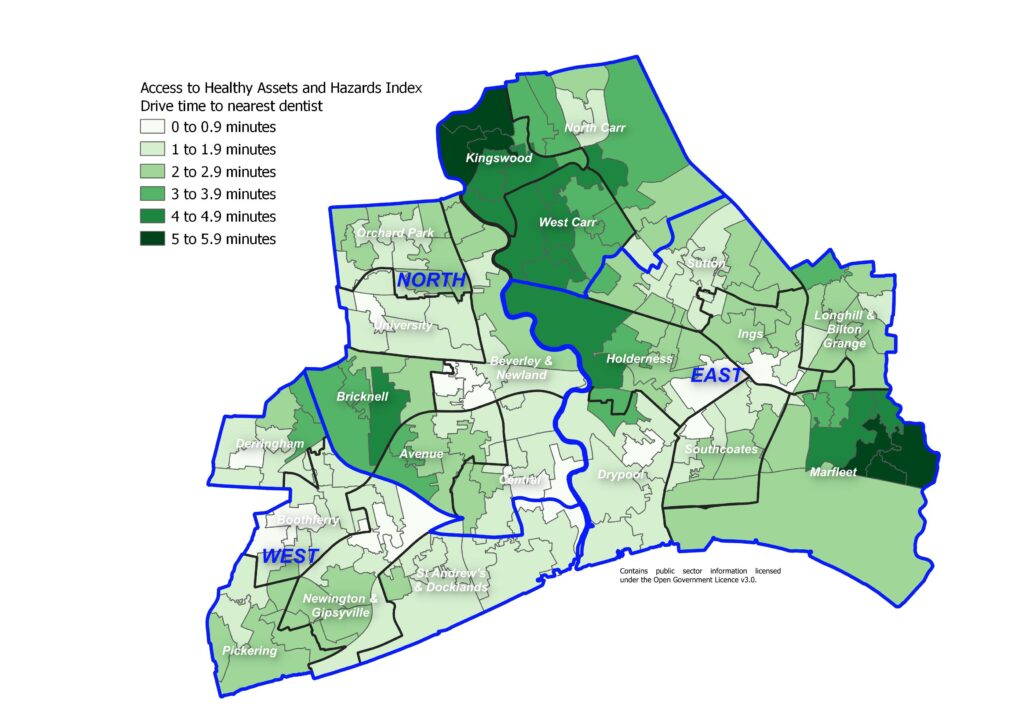
The following map illustrates the distance from the nearest GP in terms of driving time. All residents live within a five minute drive of their nearest GP surgery
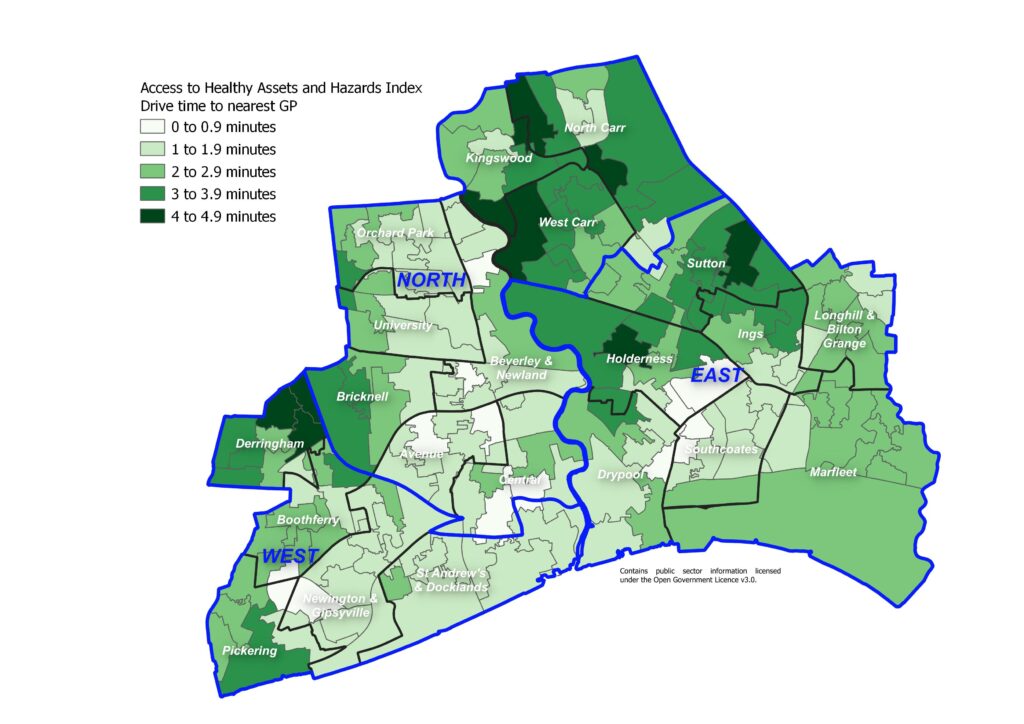
The following map illustrates the distance from the nearest hospital in terms of driving time. All residents live within a five minute drive of their nearest hospital.
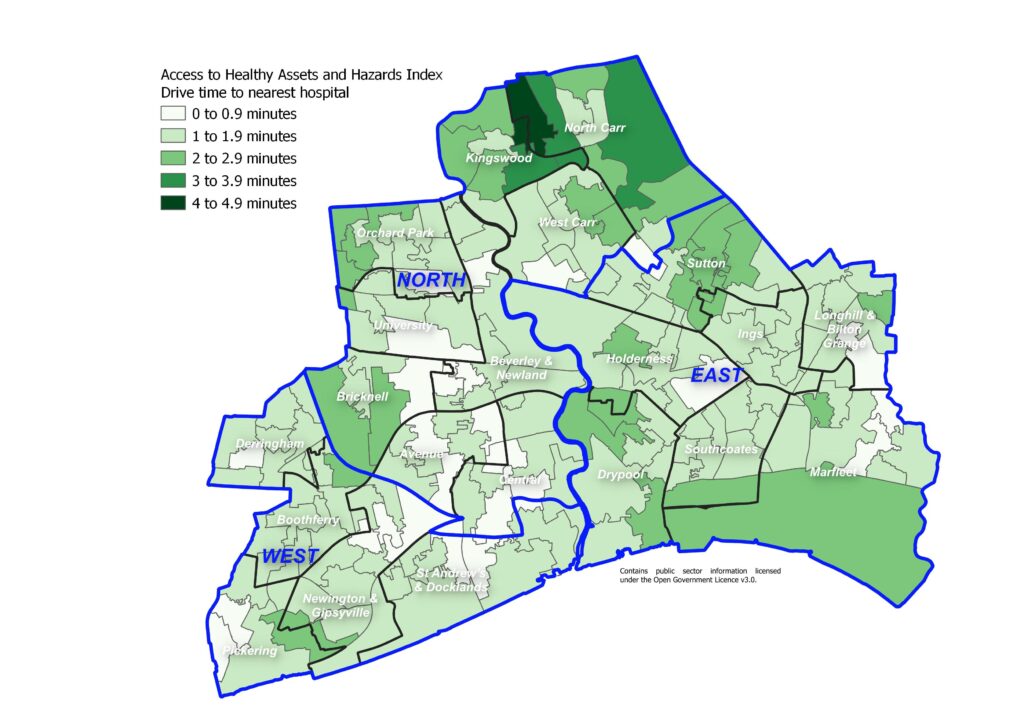
The following map illustrates the distance from the nearest pharmacy in terms of driving time. All residents live within a five minute drive of their nearest pharmacy.
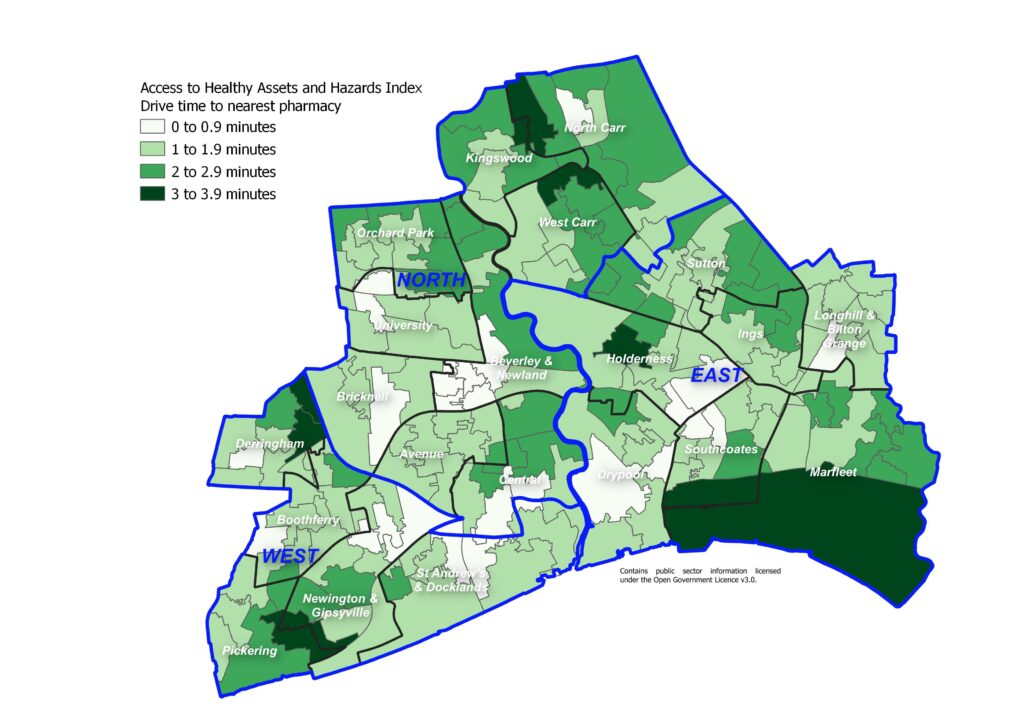
With Hull being a compact city with low drive times to health facilities, the majority of areas of Hull perform well in relation to the other geographical areas across the country particularly areas of Hull around the city centre, up Beverley Road (on the boundary splitting Avenue and Central wards, and splitting University and Orchard Park wards from Beverley & Newland) along Holderness Road (on the boundary splitting Southcoates from Holderness), along Anlaby Road where the hospital lies (splitting the southern boundary of Central from St Andrew’s & Docklands), along Cottingham Road (splitting University and Bricknell wards) and Spring Bank West (which runs from Central through parts of Avenue towards Boothferry). Areas to the north and east of the city such as Kingswood, North Carr, West Carr, Holderness, Sutton and Marfleet tend to have higher drive times to health facilities compared to other areas of Hull. The percentile scores range from 2 to 83 so none of Hull’s 168 lower layer super output areas are the the worst 10% nationally in terms of drive times to health facilities.
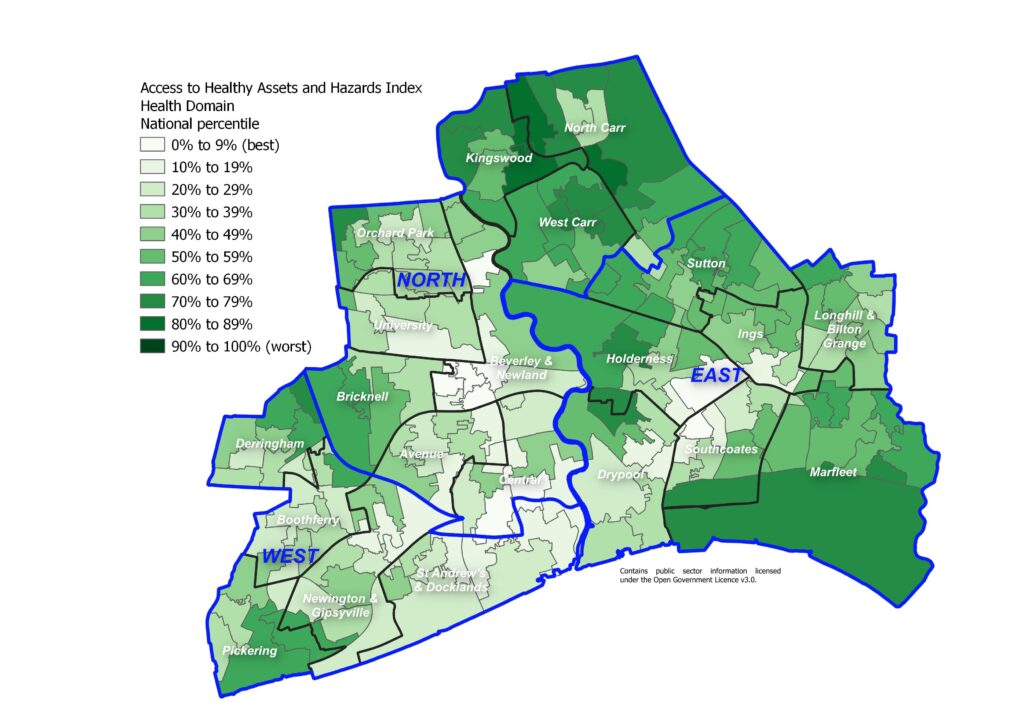
Retail Environment
The following map illustrates the distance from the nearest fast food outlet in terms of driving time. It can be seen that the majority of Hull residents live in an area where it is only a couple of minutes drive from the nearest fast food outlet, and all areas of Hull are within a five minute drive of fast food.
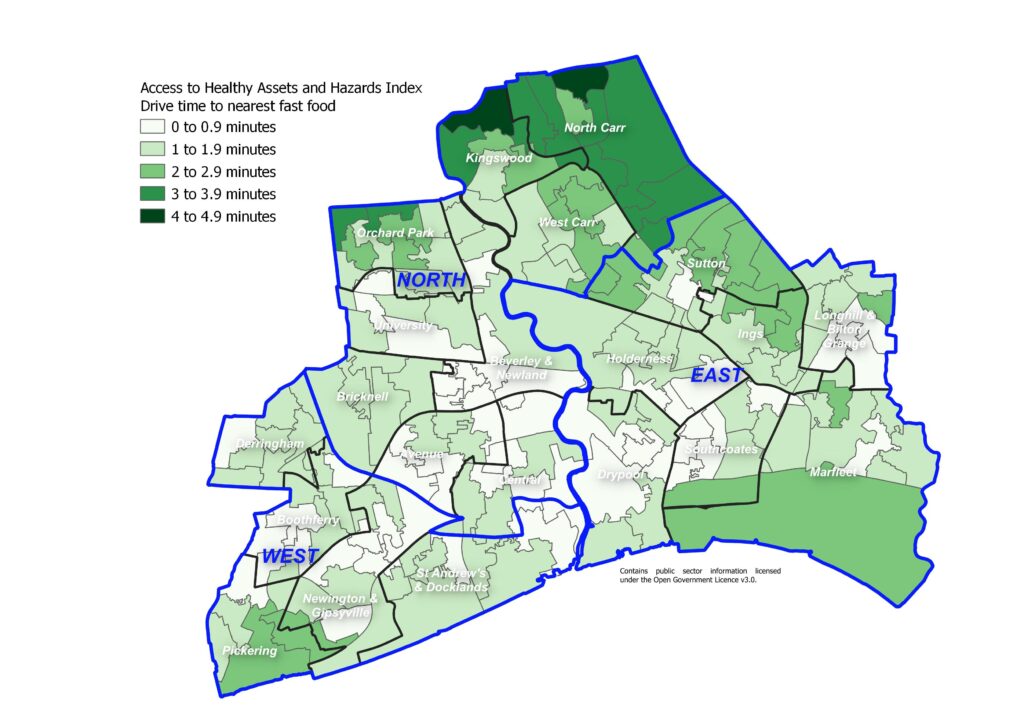
Information relating to the density of fast food outlets can also be found under Diet and Nutrition Among Adults under Lifestyle Factors under Adults.
The following map illustrates the distance from the nearest pub, bar or nightclub in terms of driving time. The majority of residents of Hull live within a five minute drive of the nearest pub, bar or nightclub with only some areas to the north of the city in Kingswood and North Carr having a slightly longer drive time, although all residents live within an eight minute drive of the nearest pub, bar or nightclub.
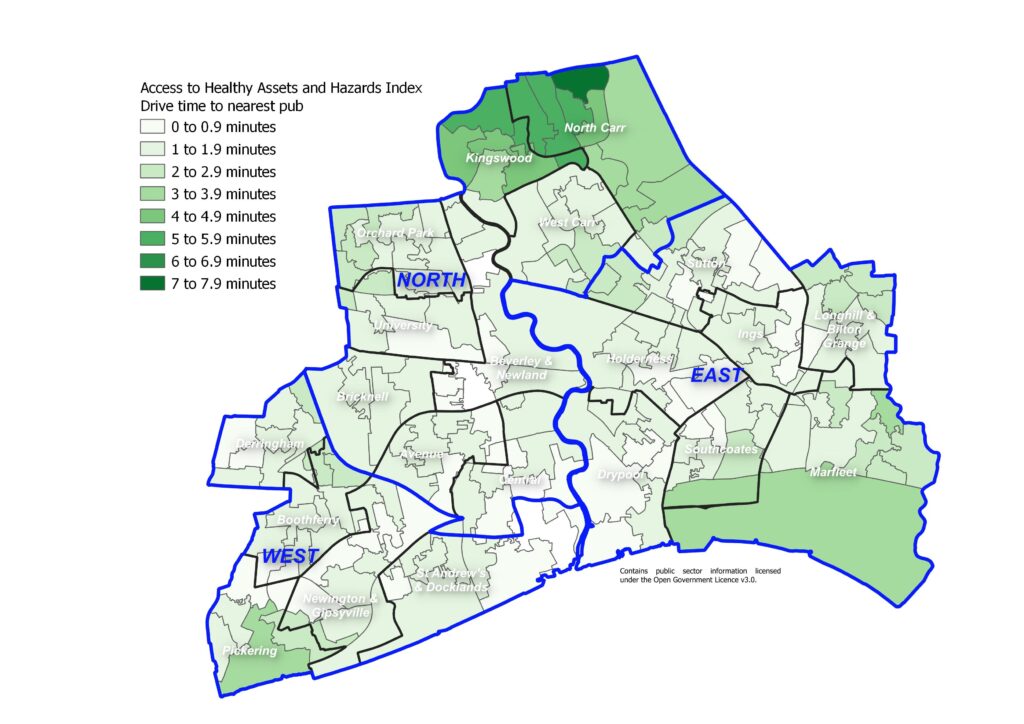
The following map illustrates the distance from the nearest gambling outlet in terms of driving time. The majority of residents of Hull live within a five minute drive of the nearest gambling outlet with only some areas to the north of the city in Kingswood and North Carr having a slightly longer drive time, although all residents live within an eight minute drive of the nearest gambling outlet.
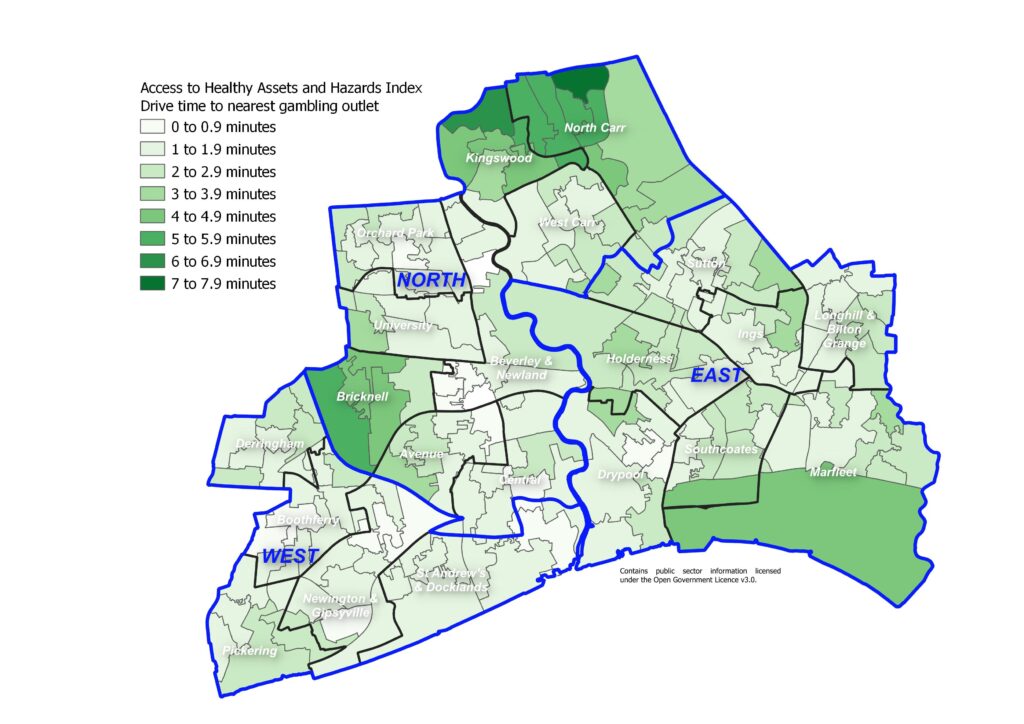
The following map illustrates the distance from the nearest tobacconist or vape store in terms of driving time. As with pubs, bars and nightclubs and with gambling outlets, the majority of residents of Hull live within a short minute drive of the nearest tobacconist or vape store with only some areas to the north of the city in Kingswood and North Carr having a slightly longer drive time, although all residents live within an an 11 minute drive of the nearest tobacconist or vape store.
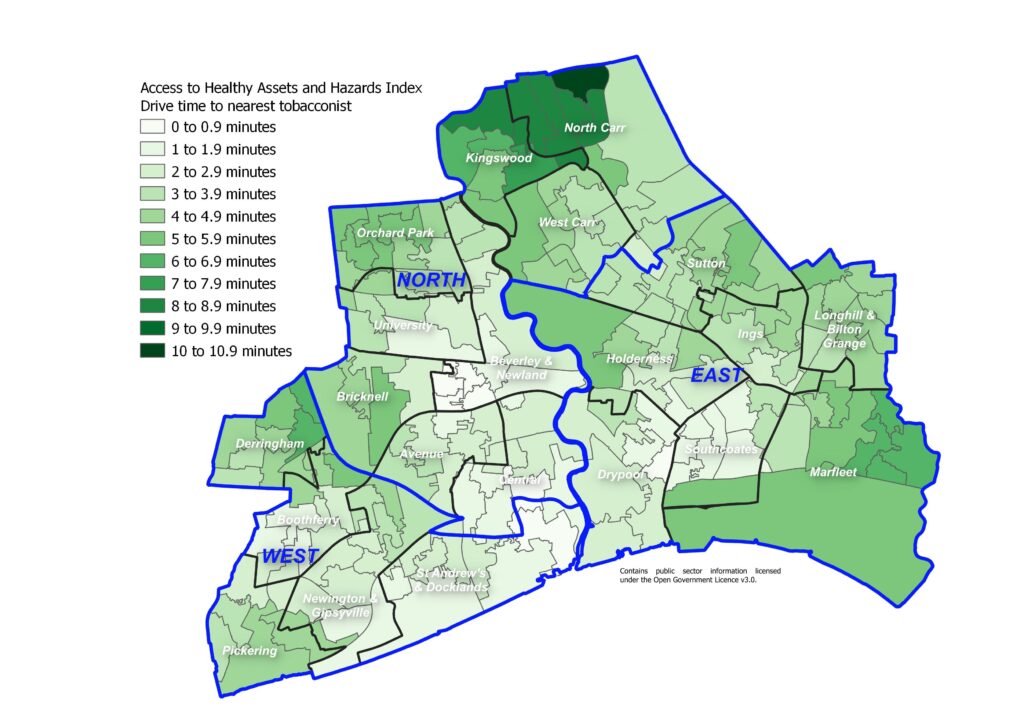
The following map illustrates the distance from the nearest leisure centre in terms of driving time. The majority of residents living around the city centre, to the south west of the city, and around the University are only a few minutes drive from the nearest leisure centre. Residents living on the north, north west and east boundaries of Hull have a slightly longer drive time, although all residents are within a nine minute drive of the nearest leisure centre.
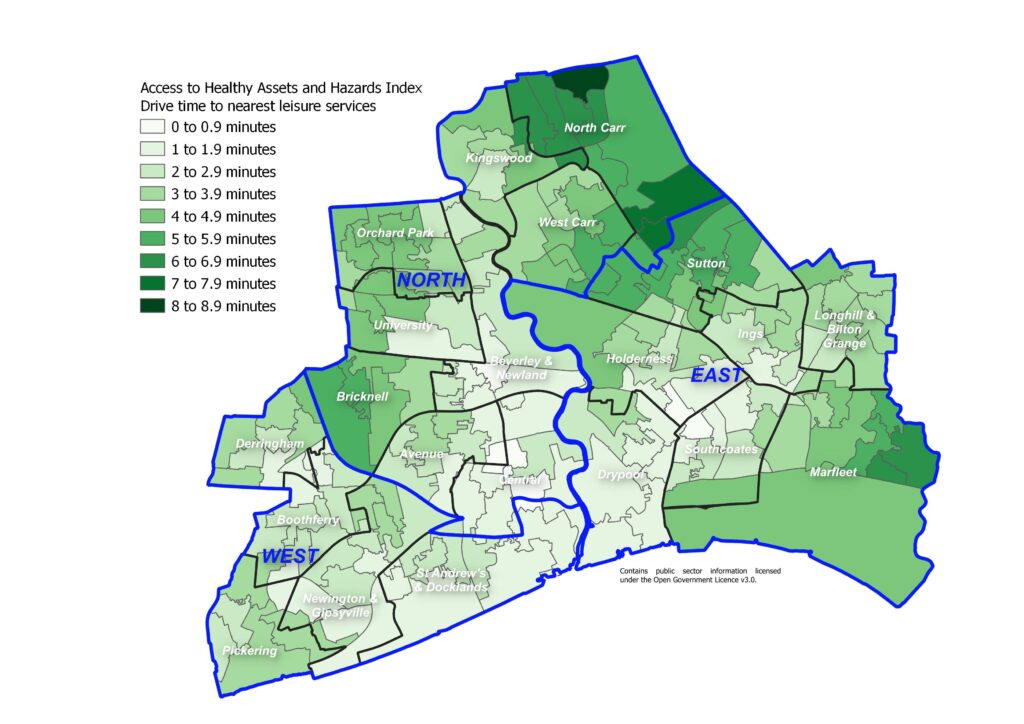
With Hull being a compact city with low drive times to retail facilities, the majority of areas of Hull perform poorly in relation to the other geographical areas across the country with relatively low drive times to fast food outlets, pubs, tobacconists and gambling outlets). The worst areas in Hull tend to be similar areas to those which performed well on the health domain as they are areas close to main roads with a relatively high number of retail and health units. These areas include areas around the city centre, up Beverley Road, along Holderness Road, along Anlaby Road (all the way along from Central ward to Hull’s boundary in Boothferry, along Hessle Road (in St Andrew’s & Docklands and Newington & Gipsyville wards), along Cottingham Road and along part of Sutton Road (within Beverley & Newland ward linking West Carr and Orchard Park wards). Areas to the north and east of the city such as Kingswood, North Carr, West Carr, Holderness, Sutton and Marfleet tend to have higher drive times to health facilities compared to other areas of Hull. The percentile scores range from 13 to 100 so none of Hull’s 168 lower layer super output areas are the the best 10% nationally in terms of drive times to retail facilities. Seven in ten of Hull’s lower layer super output areas are in the worst 50% of areas of England in terms of short distances from fast food outlets, pubs, tobacconists and gambling outlets. Areas in Kingswood and North Carr in particular are among the best areas in terms of the retail domain.
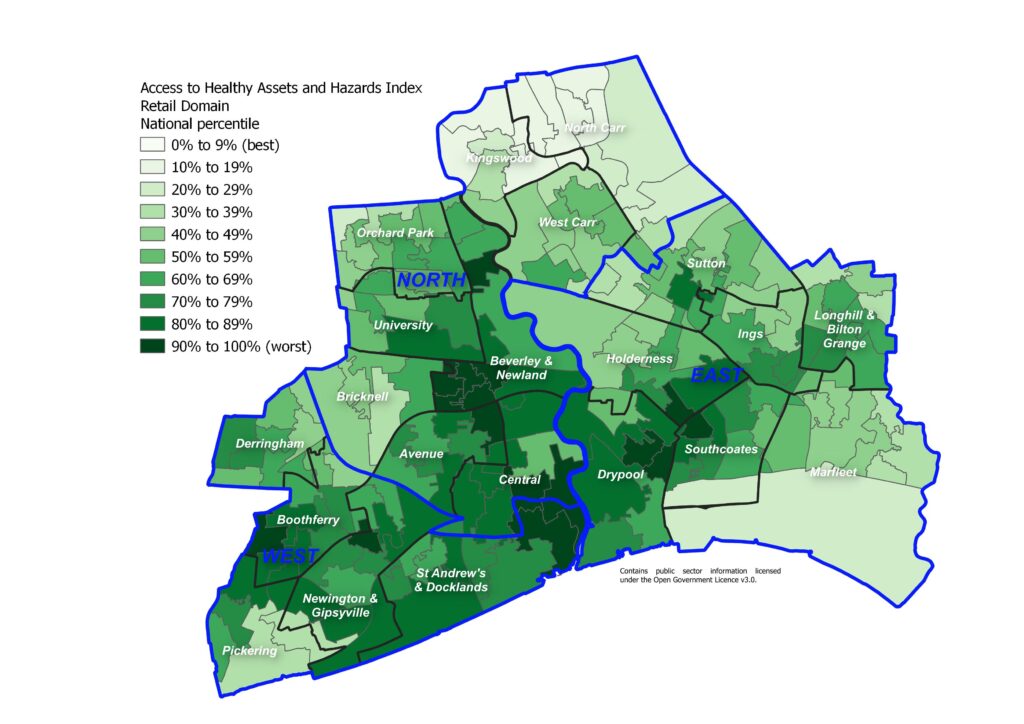
Access to Blue and Green Space
As mentioned above, drive times do not fully capture access to good quality, safe blue and green space where residents want to spend their time for health-related reasons.
The following map illustrates the distance from nearest blue space in terms of driving time.
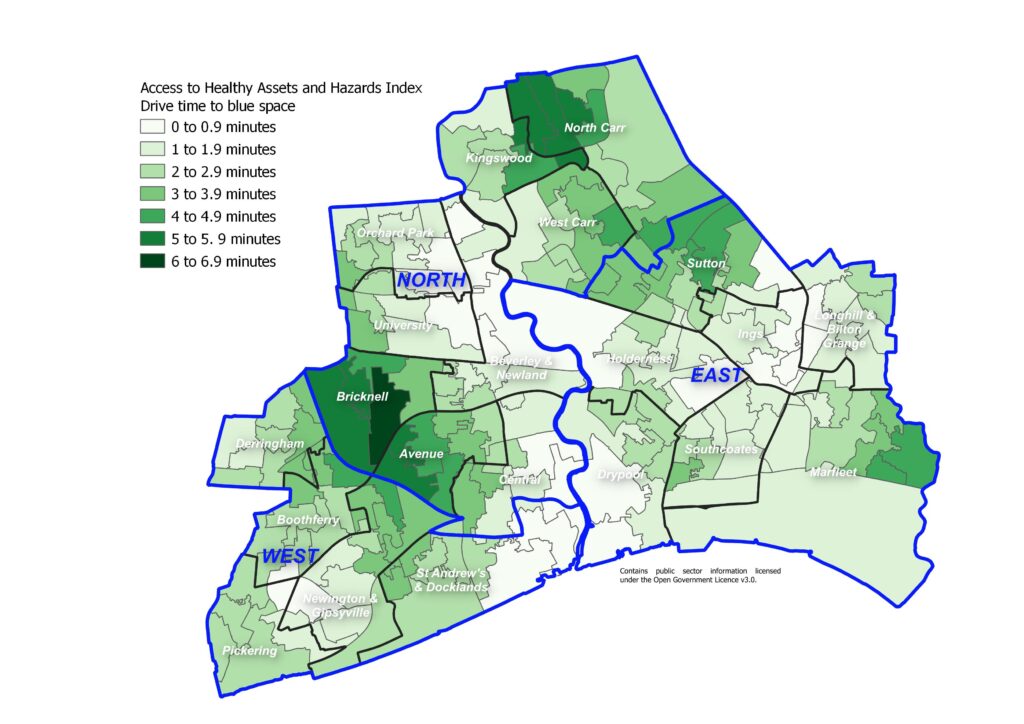
As mentioned above, green space is measured by satellites as the average Normalised Difference Vegetation Index as close to summer equinox as possible. The Normalised Difference Vegetation Index takes a value from zero (no vegetation or dead vegetation) to one (very healthy vegetation) and the measure of green space in the Access to Healthy Assets and Hazards index uses the average Normalised Difference Vegetation Index for an 80 metre radius around the postcode centroid for each postcode (the rational is that the average extent of a postcode in the UK is around 160 metres by 160 metres). Therefore, it is essentially measuring the ‘greenness’ of an area. This does not necessarily equate to assess and quality of that space. Other people’s gardens would be included in the green space measure. Furthermore, even if the green space is a public space, other factors may influence its use such as feelings of safety (and feelings of safety do differ by deprivation in Hull).
It can be seen that there is less green space in the more industrial areas of the city (an inverted T-shape along the south boundary following the A63 and from south to north following the route of the River Hull up the middle of the city).
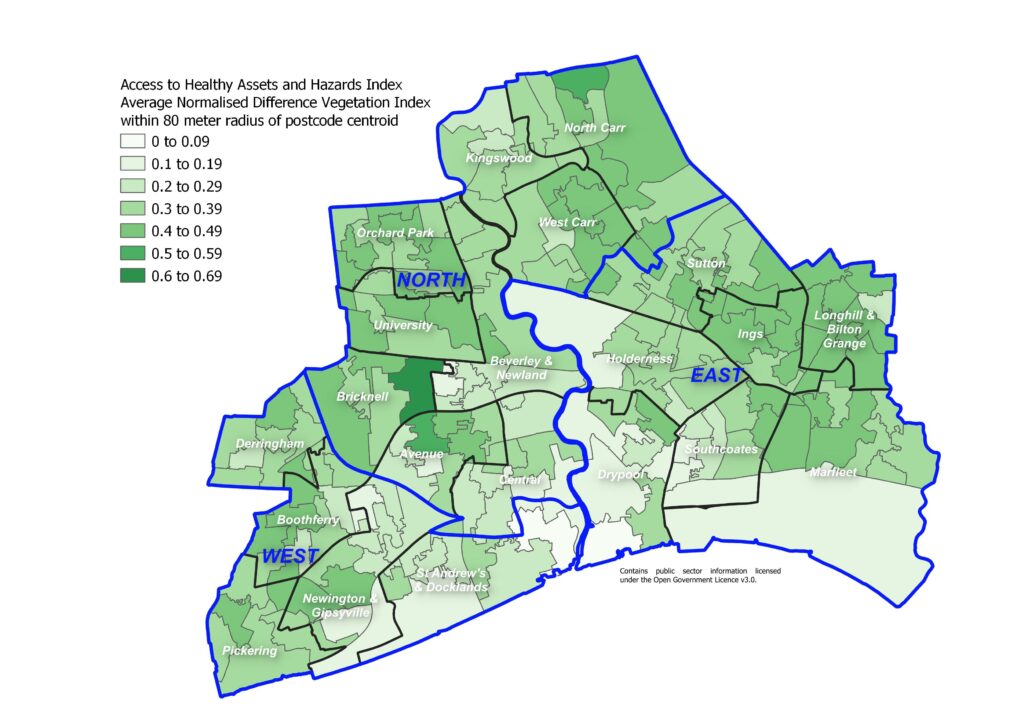
Given that drive times to the nearest blue and green space in Hull is relatively low, it is perhaps a surprise that Hull has such a range of areas from best to worst in terms of drive time to blue space and green space nearby with the percentile scores ranging from 3 to 99 in Hull. However, to an extent the blue and greens spaces counterbalance each other. The more industrial areas of Hull generally tend to be close to blue space, but tend to have the lowest scores for ‘greenness’. So this might be a factor in explaining the range in Hull.
Areas around the west from Bricknell in the north to St Andrew’s & Docklands and Newington & Gipsyville in the south, areas near Drypool and Southcoates, and areas near Kingswood and North Carr tend to be the worst areas in Hull in terms of access to blue and green space.
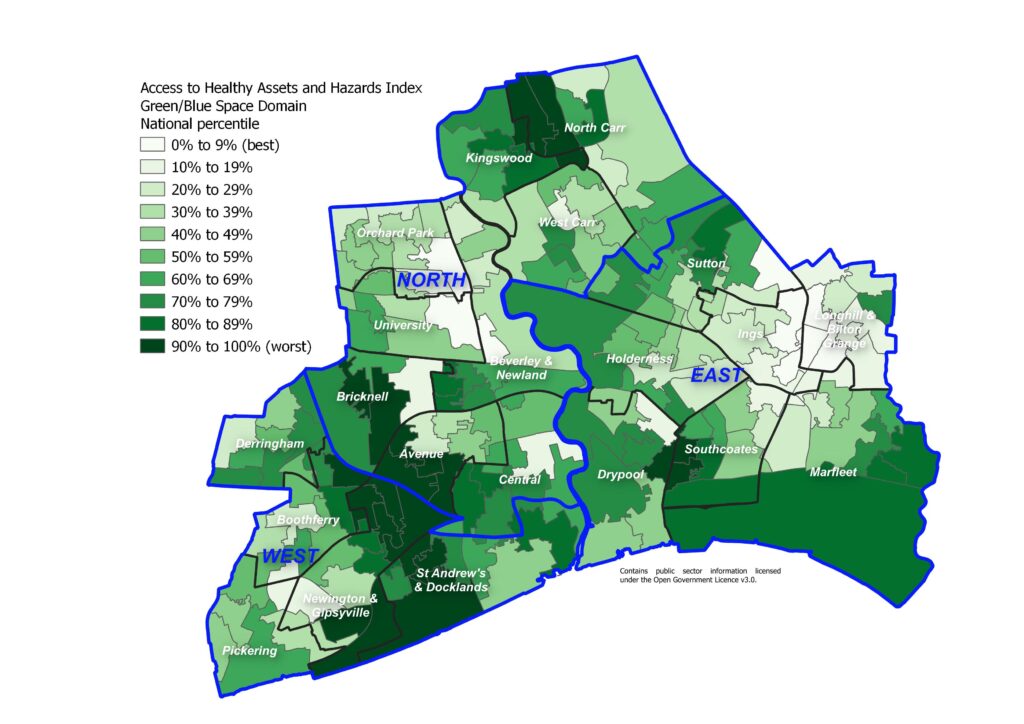
Air Pollution
The following map illustrates the average annual levels of nitrogen dioxide. Levels of air pollution tend to be higher along main arterial travel routes and in areas with higher levels of industry and this is the case for Hull. Furthermore, as the prevailing wind in the UK is predominantly from the south-west, this generally means that air pollution levels tend to be higher in easterly areas.
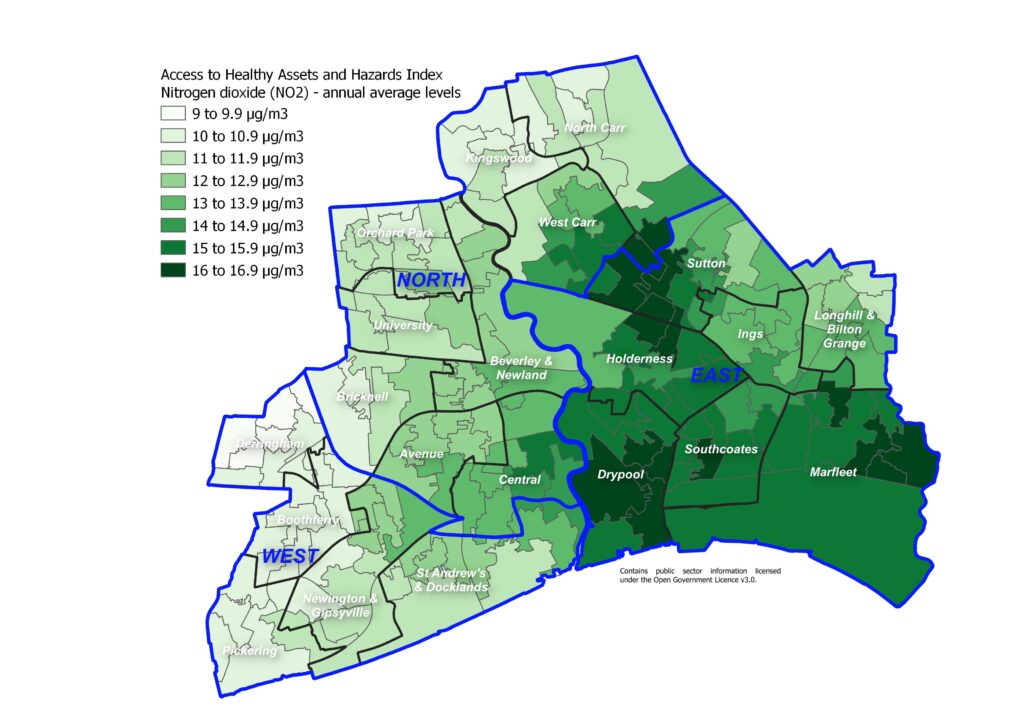
The following map illustrates the average annual levels of sulphur dioxide. There appears to be two pockets of areas with relatively high levels of sulphur dioxide in Hull and areas further away from these two areas tending to have the lowest levels compared to the Hull average.
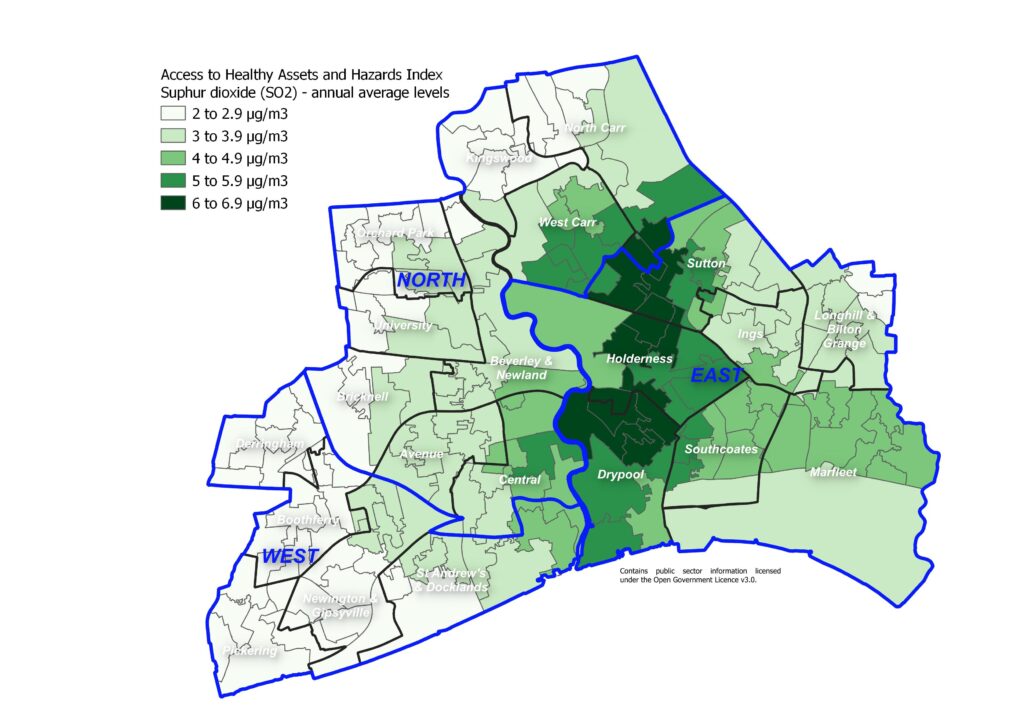
The following map illustrates the average annual levels of particulate matter with size less than 10 microns.
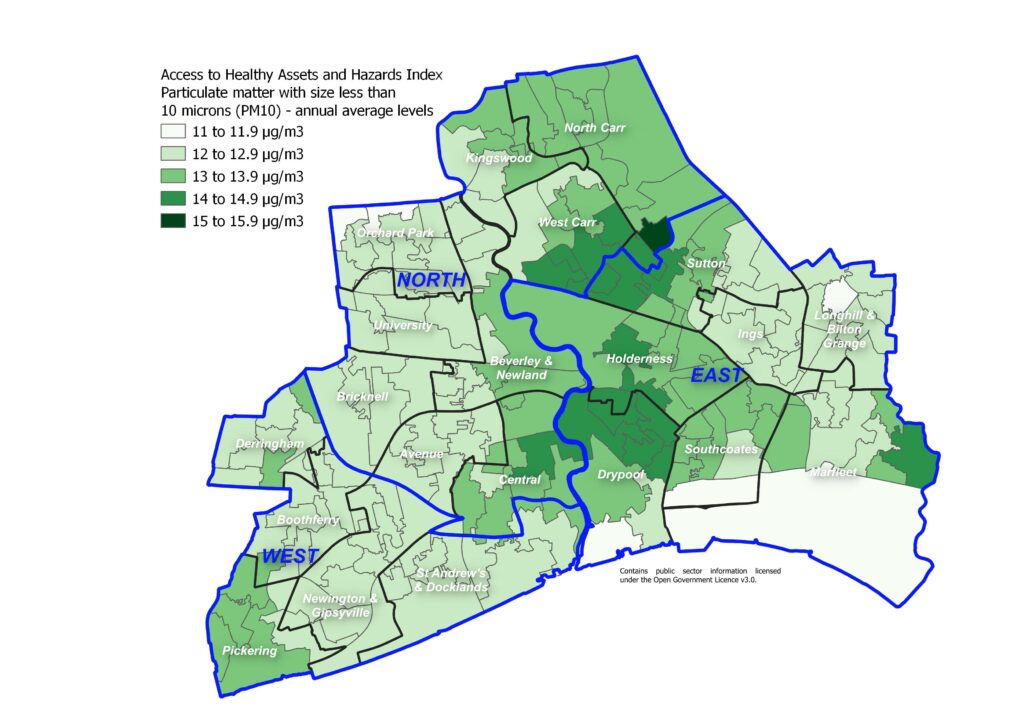
The levels of air pollution in terms of average annual levels of nitrogen dioxide, sulphur dioxide and particulate matter with size less than 10 microns are high relative to other areas of England. This is not particularly surprising as most cities with relatively high density of roads and industry compared to rural areas will tend to have relatively high levels of air pollution. Not surprisingly, the areas with the highest levels of pollution are those with the higher levels of industry and in the east where the prevailing wind will tend to increase levels of air pollution.
The percentile scores range from 68 to 100 so none of Hull’s 168 lower layer super output areas are the the best 60% nationally in terms of air pollution levels. Four in ten of Hull’s lower layer super output areas are in the worst 10% of areas of England in terms air pollution levels, and almost seven in ten of the areas are in the worst 20% nationally. All but two of Hull’s 168 lower layer super output areas are in the worst 30% of areas nationally in terms of air pollution.
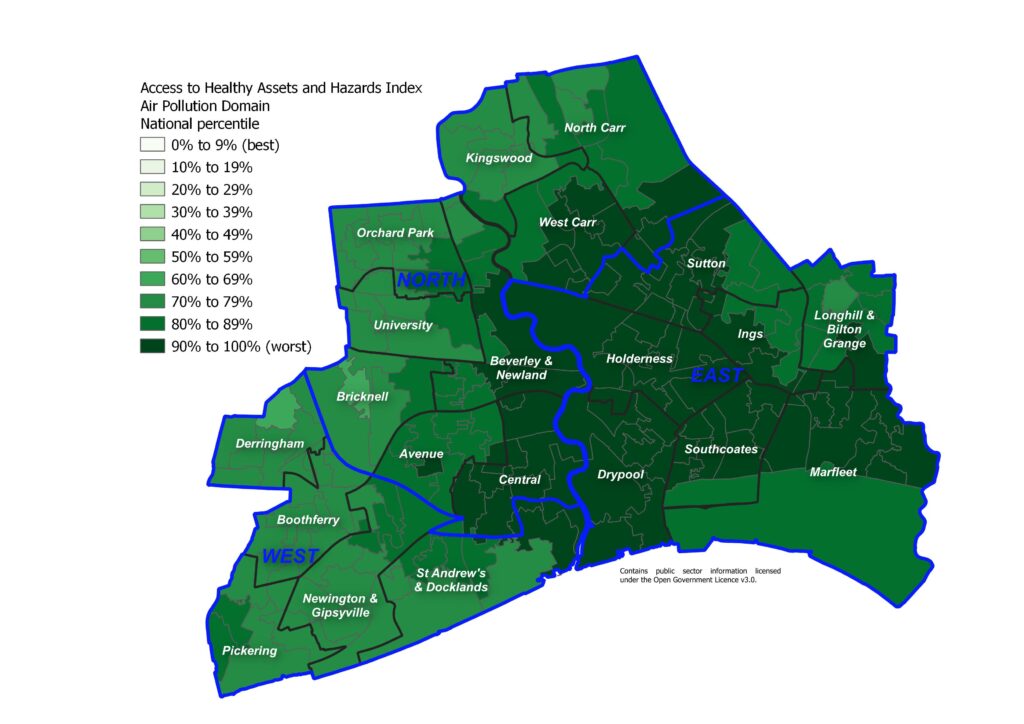
Further information on the environmental factors of Air Pollution and Climate Change can be found within Health and Wellbeing Influences.
Strategic Need and Service Provision
Most of the above factors in terms of physical and organisational boundaries are fixed and not amenable to change. However in the absence of altered local authority boundaries, they reinforce the need for close and collaborative working with local geographic partners, particularly in the East Riding of Yorkshire, and areas included within the the Humber and North Yorkshire Health and Care Partnership. The upside of Hull’s tight boundaries is that access to central services in Hull City Centre is relatively good for the majority of the public, with good transport links radiating to and from the City Centre. Links such as bus routes are often less good between communities “around the edge” of Hull, which may be physically near to one another but not have easy access.
The aim of the Humber and North Yorkshire Health and Care Partnership is to work together to help everyone have the best start in life, live well and grow older well. Making sure that every child has the best start in life, making sure that everyone can access the right care and support when their health changes, supporting people to be independent and in control as they get older, and making sure that people can talk about what they want to happen when when they die. Their priorities are as follows:
- Helping people to look after themselves and stay well;
- Making sure services are joined across health and care;
- Making sure we have the right care in certain areas; and
- Making sure we are using our resources well.
The Humber and North Yorkshire Health and Care Partnership’s approach may be different across the different geographical areas depending on the characteristics within each area.
There has been significant recent investment in Hull revealed within Hull’s City Plan both before, during and after the City of Culture year of 2017.
The ambitions of the Hull’s City Plan are to make Hull the leading hub for renewable energy industries (UK Energy City), make Hull a world-class visitor destination (Destination Hull) by capitalising on Hull’s role as UK City of Culture 2017, the multi-million pound investment into the city’s cultural and tourism infrastructure, and making Hull a place of opportunity for all, building strong and resilient communities by focusing on safeguarding the most vulnerable, prevention and early intervention, and making money go further (Community and Opportunity). Significant progress has already been made in these areas, and it is necessary to ensure that this momentum is built upon and developed within the wider context of the need to de-carbonise the economy to reduce the impact of climate change and ensure effective resilience to climate change.
Since January 2013, Hull City Council has held the highest Green Accreditation for its environmental management system, Investors in the Environment and undertaken work to reduce its carbon emissions in line with its corporate targets. It has also undertaken climate adaptation risk assessment for Housing, Museums and Gallery, Waste Management, and Parks and Transport services.
It is necessary to work together to maintain and expand an environment that promotes physical activity and active lifestyle opportunities in everyday settings for all ages. There is also a need to work with partners to ensure the design of the built environment discourages crime and fear of crime.
We need to increase access to traditional environmental spaces including parks, nature areas, gardens, cycle paths, recreational paths and water courses to improve physical and mental well-being and ensure that these are maintained in a sustainable way.
There should be support for sustainable and seasonal approaches to food use within the City to support healthy eating within health and care environments through the Green Kitchen Standard and support residents in cooking and eating healthily.
In terms of improving the environment for the people of Hull, it is important that any measures in the proposed climate change strategy and proposed action plan consider the implications on and as far as possible complement those in the Air Quality Strategy, as some could have a detrimental impact on air quality. For example, monitoring during the COVID-19 lockdown indicates that as direct emissions from vehicles decrease (mono nitrogen oxide and nitrogen dioxide combined) it has the potential to result in an increase in the concentrations of other potentially harmful gases, such as ozone, and only a minimal reduction in the emissions of particulate matter. This has implications and will need to be considered when advocating a change to electric vehicles.
Resources
Ward and Area Committee Area Profiles
Humber and North Yorkshire Health and Care Partnership. https://humberandnorthyorkshire.org.uk/
Public Health England (now Office for Health Improvement & Disparities). Spatial Planning for Health: An evidence resource for planning and designing healthier places, 2017.
https://assets.publishing.service.gov.uk/media/5b59b090e5274a3ff828c70c/spatial_planning_for_health.pdf
Updates
This page was last updated / checked on 24 October 2025.
This page is due to be updated / checked in October 2026.